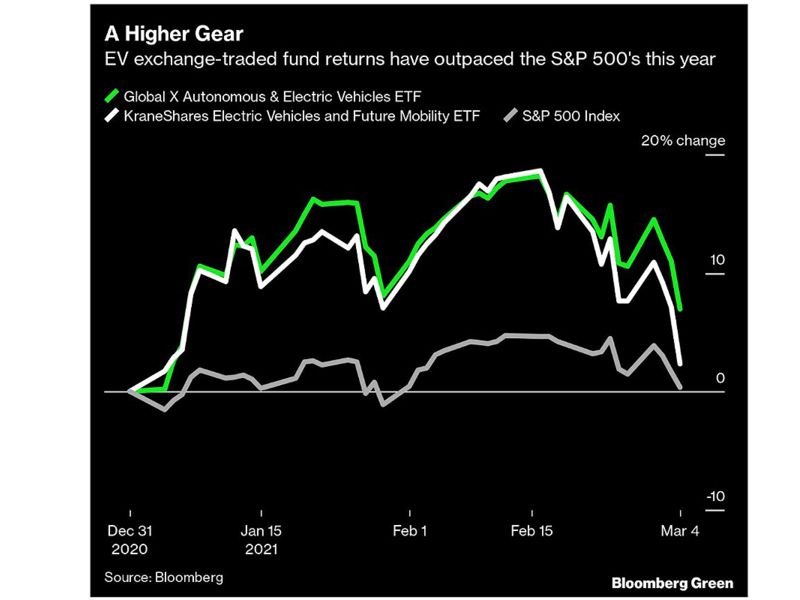
A plunge in the stocks of EV makers and suppliers is lashing investors who plowed billions into the sector this year in a bid to surf one of Wall Street’s hottest trends.
Tesla Inc. led this week’s drop in the auto sector that’s battered the holdings of funds focused on this part of the market. That’s painful for traders who poured almost $2 billion into electric car and battery-focused exchange-traded funds in 2021, according to Bloomberg Intelligence. Exchange traded fund assets in the segment had swelled to a record $4.6 billion before the selloff.
“Clearly electric vehicles are here to stay, but it’s less clear who the winners are going to be,” said Chris Grisanti, chief equity strategist at MAI Capital Management. “The market has been treating all these companies as if they are going to be winners, whereas we know that’s probably not going to be the case.”
A higher gear
Investors have been jumping in following the election of President Joe Biden, who they expect will unleash a slew of clean-energy policies.
At the same time, automakers are shifting wholesale into EVs. General Motors CEO Mary Barra pledged in late January, after Biden’s inauguration, to sell only zero-emission models starting in 2035. Volvo Cars announced an ambitious goal this week to solely market battery cars by 2030, accelerating its plans following a jump in consumer demand.
“We’re seeing an arms race in EV,” said Dan Ives, senior equity research analyst at Wedbush Securities. “A lot of (trading funds) are giving investors the ability to invest in not just one EV player, but the whole space.”
Two of the best-performing funds have been the KraneShares Electric Vehicles and Future Mobility Index, or KARS, and Global X Autonomous & Electric Vehicles, or DRIV. Each lost more than 6.6 percent of their market value in the past three trading sessions.
KARS just had its best-ever month of inflows and its shares have still gained 2.3 percent year-to-date, compared with the 0.3 percent advance of the S&P 500. DRIV has climbed almost 7 percent in 2021 and already attracted about $560 million of inflows — more than double the amount for all of 2020.
However, a good chunk of fund gains — and perhaps interest in the sector — can be attributed to Tesla. The automaker is among DRIV’s 10 largest holdings, for example. It’s the second-biggest holding in BlackRock’s iShares Self-Driving EV and Tech ETF, or IDRV.
Tesla dropped 4.9 percent on Thursday. Elon Musk’s company is still up more than 300 percent in the past year, even after the stock fell about 30 percent from its peak in late January.
Meanwhile, the surging investor interest in EVs has coincided with a boom in special purpose acquisition companies, or SPACs, which has led to the likes of Lucid Motors Inc. and Xos planning to go public through blank-check operations.
All that has stirred concern in some corners of the market that the sector may be over-heating.
Still, worldwide sales of EVs increased 15 percent in 2020, according to data compiled by Bloomberg, boosted by additional green policies and stimulus measures from governments across the globe. By 2040, more than half of all passenger vehicles sold worldwide are projected to be electric.
“We’re seeing an increase in popularity in these themes like electric vehicles because investors are looking for a way to implement some of these important policy tailwinds,” said Lauren Goodwin, an economist and multi-asset portfolio strategist at New York Life Investments.